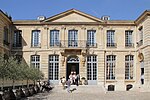Sainte-Clotilde, Paris
1857 establishments in France19th-century Roman Catholic church buildings in FranceBasilica churches in ParisGothic Revival church buildings in FranceRoman Catholic churches completed in 1857 ... and 1 more
Roman Catholic churches in the 7th arrondissement of Paris

The Basilica of Saint Clotilde (Basilique Ste-Clotilde) is a basilica church in Paris, located on the Rue Las Cases, in the 7th arrondissement. It is best known for its twin spires.
Excerpt from the Wikipedia article Sainte-Clotilde, Paris (License: CC BY-SA 3.0, Authors, Images).Sainte-Clotilde, Paris
Rue Las Cases, Paris Faubourg Saint-Germain (Paris)
Geographical coordinates (GPS) Address Phone number Website External links Nearby Places Show on map
Geographical coordinates (GPS)
| Latitude | Longitude |
|---|---|
| N 48.858333 ° | E 2.319167 ° |
Address
Basilique Sainte-Clotilde (Basilique Sainte-Clotilde-et-Sainte-Valère)
Rue Las Cases 23 bis
75007 Paris, Faubourg Saint-Germain (Paris)
Ile-de-France, France
Open on Google Maps










